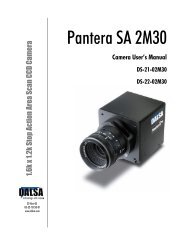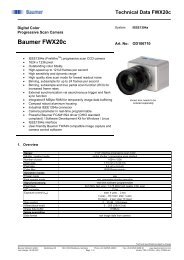TR-33 TR-34 TR-35 Trillium Rhino User's Manual - Frame Grabbers
TR-33 TR-34 TR-35 Trillium Rhino User's Manual - Frame Grabbers
TR-33 TR-34 TR-35 Trillium Rhino User's Manual - Frame Grabbers
You also want an ePaper? Increase the reach of your titles
YUMPU automatically turns print PDFs into web optimized ePapers that Google loves.
42 <strong>Trillium</strong> User’s <strong>Manual</strong><br />
Environment<br />
The camera and cables should be shielded from environmental noise sources for<br />
best operation. The camera should also be kept as cool as possible. Specified<br />
operating temperature is 0-50° C. The camera case is vented to allow for<br />
convection cooling. Some environments may warrant a cooling fan.<br />
At temperatures below <strong>35</strong>°C, convection cooling has proven to be sufficient if a<br />
reasonable airflow is maintained around the camera. For higher temperatures,<br />
some minimal forced air circulation may be necessary. Requirements can be<br />
determined by reading the camera's internal temperature using the<br />
verify_temperature command after the camera has stabilized. For best<br />
performance, keep the operating temperature below the de-rating curves.<br />
De-rating curves<br />
4.2 Optical Interface<br />
i<br />
For more<br />
information on<br />
lenses and<br />
chromatic<br />
aberration, see<br />
DALSA’s<br />
“Correcting<br />
Chromatic<br />
Aberration”<br />
application note,<br />
doc# 03-32-<br />
00363.<br />
In some applications requiring long integration times, an increase in Charged<br />
Conversion Efficiency (CCE) by the IL-P3 sensors may result in large dark<br />
offsets, caused by the amplification of temperature generated dark signal<br />
integrated over long periods. This effect has an impact on the ability of the<br />
camera to correctly calibrate itself. See Appendix E, for further information on<br />
the de-rating curve.<br />
Note: The de-rating curve applies only to applications requiring long integration<br />
times, not necessarily low line rates. For example, a web inspection application<br />
where line rates may vary considerably but integration time is limited to a short<br />
duration will not experience a dark offset issue.<br />
Lenses<br />
For 1k resolutions, images may be obtained with high-quality F-mount lenses<br />
(e.g. Nikon NIKKOR 55mm). At present, DALSA cannot recommend commercial<br />
lenses for 2k resolutions.<br />
03-32-10119-03 DALSA
















